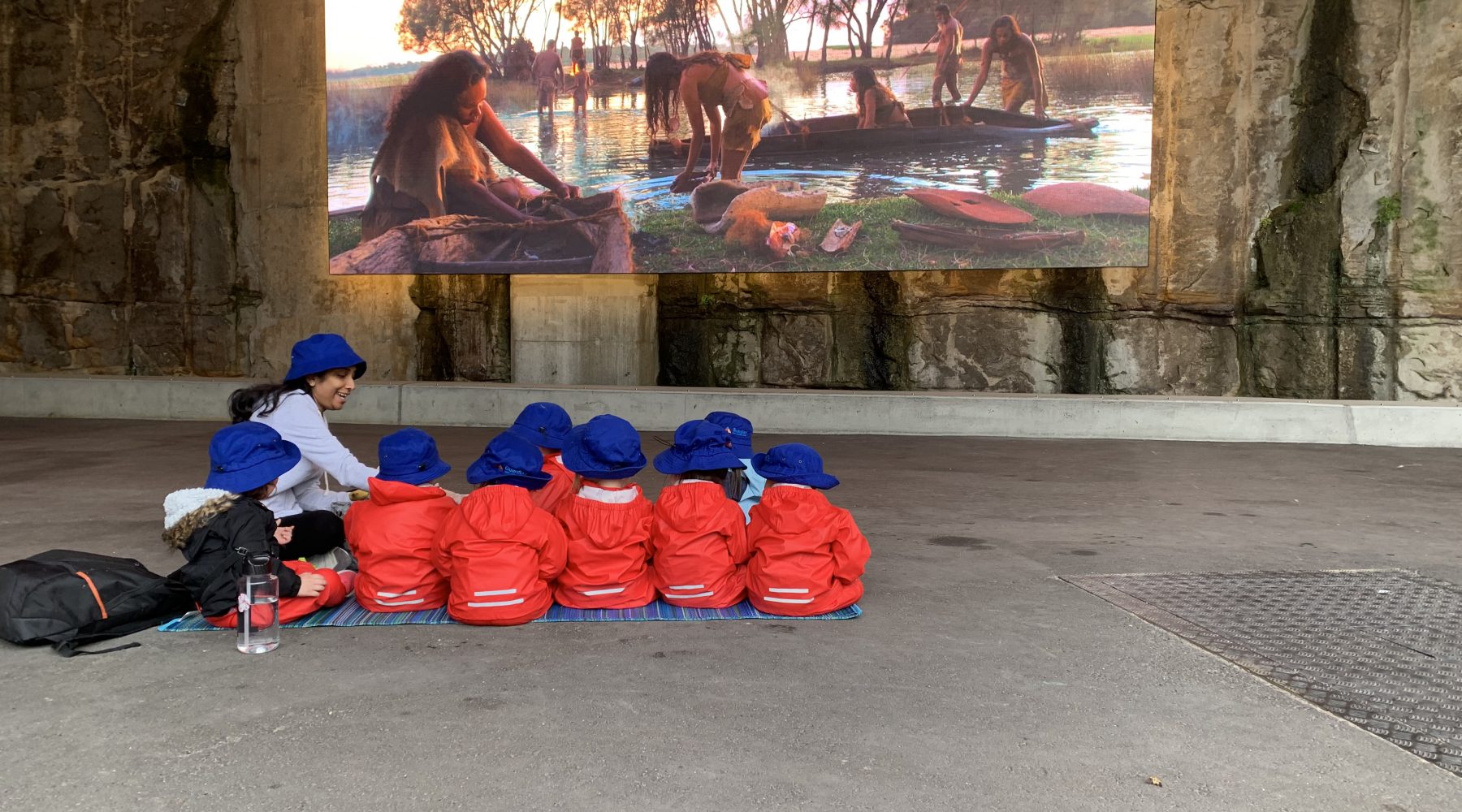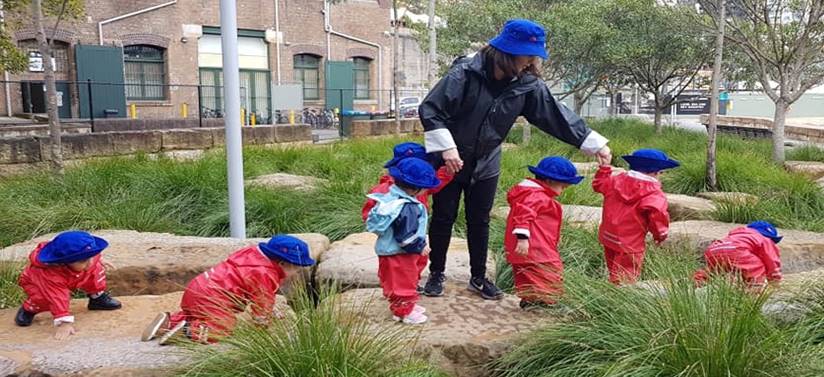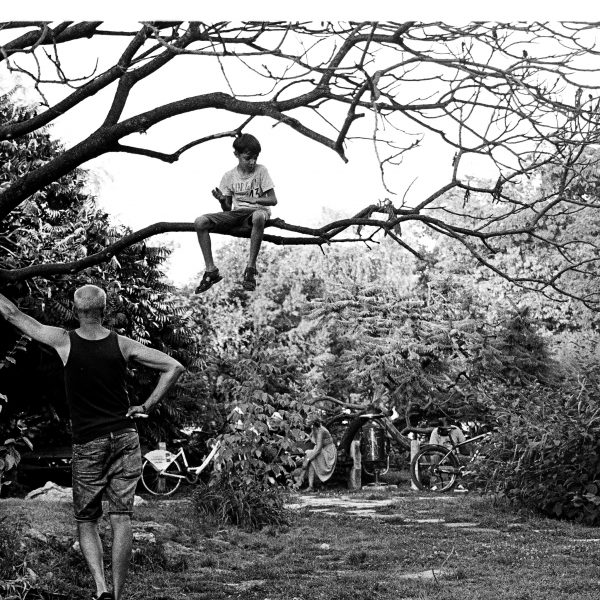Excursions as a medium for learning and advocacy

Following a recent presentation at the Macquarie University Infants and Toddlers Conference, The Sector spoke with Kate Laidley and Chloe Flannery, who work with Guardian Childcare and Education in the Barangaroo ELC.
Barangaroo, a unique development in inner city Sydney, covers 22 hectares, and is described as “a dynamic retail, cultural and financial hub” where more than 50 per cent of the precinct is allocated to public space.
How do children fit into such a space? What is the role of the educator in bringing children into the world beyond the centre, and what are some of the lessons which have been learnt along the way?
Setting the scene
Barangaroo is nestled between Sydney Harbour and the Central Business District of Sydney proper. Costing over $6 billion dollars to create, the development is “a showcase of international design excellence, leading technologies, world-class sustainability, public art and cultural programs.”
At its northern end, Barangaroo Reserve contains “an entirely Australian native garden, spectacular views, extensive walking and cycling trails, idyllic harbour coves, unique event spaces and peaceful picnic spots”.
To the south, a variety of restaurants in a cultivated dining precinct, and along the way, laneways showcasing contemporary architecture, maritime and industrial history.
Once completed, Barangaroo is expected to support more than 24,000 permanent jobs, provide a home to 3,500 residents and contribute some $2 billion each year to the NSW economy.
Excursions as part of service identity
Children attending Barangaroo ELC are a vital part of the community being built in the area, in no small part because of the visibility afforded to the children and the service through embedded practice in the centre, which sees each child, regardless of age, with the opportunity to go out on an excursion every week.
Describing excursions as “key to our service identity”, the educators at Barangaroo view them as vital learning opportunities for:
- infants and toddlers to experience challenge and risk, and to know what it means to be trusted;
- educators to develop their processes, to reflect, and to know what it means to truly trust children;
- members of the public to witness for themselves infants and toddlers as capable, confident active members of their community.
Excursions as acts of advocacy
In speaking with Ms Flannery and Ms Laidley, both emphasised the role the excursion program has played in ensuring that children and educators develop a strong and reciprocal trust.
The children trust that the adults will follow their lead in terms of the directions, planning, and following of interest on the excursions themselves, and the educators have found their voice to advocate for the rights of the child to participate meaningfully in community, and co-construct their role in this emerging suburb.
As a result, the community have sought out opportunities for collaboration with the service.
“Changing the public perception around the capabilities of infants and toddlers is not a simple goal, but placing them where they can be seen, hopefully it is achievable.” Ms Flannery and Ms Laidley said.
Being, belonging, becoming in community
Ms Laidley and Ms Flannery both spoke of the children’s sense of belonging in the community.
“We go to the same spaces because that is what they are interested in. They are facilitating that, based on their relationships with the staff at the flower shop, the bookshop. They feel a sense of belonging to those places. We’re there with them, but they know why they are going there, what they want, and how to navigate what they’re doing. “ Ms Flannery said.

Image courtesy Guardian Childcare and Education
“We had a full evacuation a few weeks ago, and our path away from the building takes us past the florist – a few children tried to go into the florist because they’ve internalised that walking this way gets you to the florist, where you can go in and say hello to Jeff or Dustin.”
“The evacuation was very calm, because it was familiar and known to the children – an extension of their space,” added Ms Laidley.
Challenges encountered
When speaking to Ms Flannery and Ms Laidley, each noted that with all of the benefits of working in a purpose built community, there were also some challenges.
With Barangaroo still evolving, in terms of its creation and construction, risk assessments of routes and spaces needs to be ongoing and dynamic. A route walked yesterday may today be blocked off, obstructed or otherwise unsafe.
As Ms Laidley said, these assessments can change week to week or day to day. As a result, educators have become more confident in conducting on the spot risk assessment and analysis.
“At first educators weren’t following the children’s interests all the time because specific things weren’t covered in the risk assessment – but so much of what’s in the area isn’t covered in a static risk assessment as the environment is constantly changing. Educators have needed to develop some autonomy in this space, and feel secure that they can cover things off without written documentation,” she added.
In order to develop more confidence in this space, she said, the leadership team looked into the regulations deeply, exploring what was required on an excursion, and if it was a regulatory requirement to staff excursions above ratio.
Ms Flannery noted that whilst challenges exist, Guardian as an approved provider “go to great lengths to get children out and about, that’s been an investment across the company, not just Barangaroo.”
Following in their footsteps – advice for other services
The Sector asked both Ms Flannery and Ms Laidley for their advice and perspective about how other early childhood education and care (ECEC) services could go about implementing an excursion program in their service.
Ms Flannery said it was important to reframe the notion of an excursion as a big event which happens once or twice during the year, to a zoo or an aquarium. “It’s ok to do small things” she said “go to your foyer, go around the corner… it’s about observing the learning opportunities which are offered in the everyday.”
“When we post photos of our excursions for the families, they engage and respond, even when we only write a few lines, because we are making the learning visible.”
The children, too, quickly become aware of what it means to be out and about. Ms Laidley said “the process of getting out the front door – we’ve learned so much about the best way to organise that, and the children have learnt with us!
“The children have learnt so much about the things we need when we go out, and have learnt that even if they aren’t going out this time, there will be next time. We have one year olds who can look at us and say “’scursion?” and we say “no, not this time” and they say “ok, I wait” – when you have a one year old who can say that, it’s quite significant.”
“Looking deeper into that comment, that observation, it shows that child internalising a concept of time, and having a level of trust that their educator will remember them, and their needs. They are internalising patience, learning how to wait – and those are things that we grapple with as adults – but one year olds are implementing and driving it,” Ms Flannery agreed.
Practical tips:
- Centre hats are easier to manage than individual hats. Have a set of hats for excursions which are washed between uses.
- Have name tags made up and ready in each room, and return them to the same place to be used again
- Store anything needed for an excursion in one spot, returning it each time
- Create an excursion folder with any relevant lists and other information
- Purchase prams which cater for eight to enable the youngest children to participate
- Work closely with the WHS supervisor to review excursion bags before going out and on return
- Complete a reflection/evaluation after each trip – to be read by educators before the next trip
- Complete and store risk assessments in such a way that they are available to all who are going through and using that route or venue, and be prepared for these to be dynamic and change
Sharing the learning – the final word
When asked what some of the biggest learning experiences, both for the educators and for the children, Ms Laidley acknowledged that the path to where the team are today has been a journey “everyone was really nervous for a really long time. We had a time when we had a senior educator on each excursion, which is fine, but if it’s to be embedded that’s not always possible.”
Embracing the uncertainty and nervousness, and reflecting on it, has resulted in big professional growth for the team “It’s been great to have educators who are newer to the profession be able to develop the confidence to say to members of the general public ‘no, you cannot touch the children. No, you cannot take photographs of the children.”
For those educators, she said, being able to have the confidence to advocate for the children’s rights, and to find their voice in articulating the importance of those rights has been a significant step.
Ms Flannery said that one of the biggest realisations for educators was also about moving out of their comfort zone.
“Educators are comfortable in their own walls, their own space. In those spaces it’s easy to implement ritual and routine, allowing children to have agency and autonomy – but what happens when you take that familiar space away? What happens when you’re out in a park in the open where you have to have high supervision, but you still want to support agency and autonomy, still want to maintain routines?”
Working through those wonderings, and giving educators the opportunity to explore these ideas, has resulted in a team which has come a long way, but also in a growth of confidence for the children.
“The reciprocal relationship, knowing that when you call their name, you can trust them to come back, even when there isn’t a barrier to stop them. They are growing in that sense and understanding which says “this is where I need to be” Ms Laidley said.
For more information about Guardian Childcare and Education, please see here. To learn more about Barangaroo, see here.
Popular

Workforce
Quality
Research
When did it start to go wrong?
2025-12-18 08:00:46
by Fiona Alston

Policy
Economics
Jobs News
Provider
Workforce
Children’s Services Award changes finalised to address gender-based undervaluation
2025-12-12 06:58:10
by Fiona Alston

Economics
Provider
Quality
Jobs News
Policy
Practice
Workforce
The year in review: 2025's most impactful ECEC news stories and shifts
2025-12-16 07:32:18
by Fiona Alston















